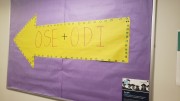At Goucher College in Towson, Maryland, there are 174 black students compared to McDaniel College’s 270 black students. Another small liberal arts college by the name of Hood College which is in Frederick, Maryland, has 238 black students. Goucher College has 77 Hispanic students compared To McDaniel’s 80 and Hood has 82 compared to McDaniel. Finally, Goucher College has only 50 Asian students compared to McDaniel’s 106 Asian students; Hood College has sixty Asian students. (“Race/Ethnicity“) Although Hood College may have more Hispanics than McDaniel, these numbers still show a significant increase.
Not only are the number of minorities at McDaniel College high but McDaniel College has partnered with the College Bound Foundation to identify and recruit inner city low-income minority students from Baltimore City. Additionally, McDaniel offers six-to-eight full tuition scholarships to highly qualified Baltimore City students annually. McDaniel also continues to partner with College Visions from Providence, Rhode Island to identify and recruit students of color. Lastly, college staff participates in college fairs conducted by 100 Black Men of Maryland, National Council of Negro Men, National Hispanic Fair, and the Hispanic Latino Fund. In contrast, Hood College uses the Go to High School, Go to College Fair in Prince George’s County to expose more than 600 students in Maryland and D.C. to various college preparation services, including the admissions process, academic preparations, and financial aid (“Recruiting Diverse“) but the amount of focus that’s on minority students is unknown.
McDaniel has many cultural clubs such as the Black Student Union, the Asian Community Coalition, and the Multicultural Club. During my first meeting of the BSU, there were many shades of brown, but to my surprise, there was an Asian, a Hispanic, and a Caucasian student there. It was a room full of openness and freedom, and for once in my life, race wasn’t a taboo topic. The ACC has students of different ethnicities such as blacks (Nigerians in particular) and Caucasians. The Multicultural club aids students in learning about the traditions, religion, and even fun things such as food from backgrounds around the world.
It seems as if McDaniel College has a high number of minorities, or at least more than competing colleges. Yet again, there are clubs that encourage diversity, but maybe this is a one-sided or superficial view of looking at things. Does anyone really sit down and talk to the students about the subject of race? In interviews that I conducted, some students said that they were unaffected by being a minority. One Ghanaian student said that she has “experienced racism” but she really “doesn’t care” because in “most of her classes” she is the only black person. Even in the Psychology of Women, it states, “Female students of color are especially ignored in the classroom.” One African-American student said that it was a “culture shock” and one Hispanic said that he has not experienced racism but he “wouldn’t be surprised if it happened because you cannot simply disregard the fact that you are part of a minority group and there are always extremists that will call you out because of your race…” Most students feel as if they are not racist but a little biased because all of their lives, they have grown up around people like themselves. While race is a hard factor to ignore, McDaniel has so many unique backgrounds that there is no way students who attend this college won’t learn to think in creative ways that they’ve never had to before.
Mahlia Joyce, who is the director of Multicultural Affairs at McDaniel College, has always seen herself as part of this college and part of what this school could do differently. She taught Spanish at local, alternative high schools in Carroll County where the majority of students were Caucasian and had certain perceptions of minorities. She felt as if her job was not to teach a language, but understand more about the culture itself. She confirms that McDaniel has had an increase in minorities. The class of 2015 is comprised of 25% minorities and as a whole 14 to 15 percent are minorities. However, she says that some students still feel isolated and disconnected. She believes that regardless of numbers, students should feel a part of the majority and it is not only up to the Office of Diversity and Multicultural Affairs (ODMA), but the students and the college as a whole. As a student, community member, worker, and alum of McDaniel College, she has always wanted to be a part of the solution.
There is absolutely no reason to be skeptical about being a student at McDaniel College. It is understandable that many freshman students may not know what to expect during their college experience because they are venturing away from home and most of them have grown up in one place all of their lives with one view of the world around them. Slowly, but surely, college will be easier to adapt to because students will take classes, join clubs, and travel with people that have the same interests and race won’t matter. A blogger by the name of Aaron Thompson who is a professor of sociology at Eastern Kentucky College says that diversity enhances self-awareness, expands worldliness, and enhances the multiple perspectives developed by a liberal arts education. McDaniel College exemplifies diversity in a positive and life changing way.


